
 JP Weaver’s origins began in the late 19th century when 18-year-old Joseph Pearce Weaver founded his eponymous business in West Derby, Lancashire County, England. His father George was a master carver and gilder under who’s tutelage Joseph’s craft was honed. Numerous ecclesiastical and public projects imbued father and son with a reputation of “most excellent and brilliant workmanship.” After his father’s illness, Joseph threw himself headlong into his small local business, and soon the young man found himself taking on much larger commissions throughout greater London. In 1886 when Joseph turned 20, the same year the Statue of Liberty was officially dedicated in New York Harbor, the allure of living and working in the United States with its magnificent prospects and opportunities drew him across the Atlantic.
JP Weaver’s origins began in the late 19th century when 18-year-old Joseph Pearce Weaver founded his eponymous business in West Derby, Lancashire County, England. His father George was a master carver and gilder under who’s tutelage Joseph’s craft was honed. Numerous ecclesiastical and public projects imbued father and son with a reputation of “most excellent and brilliant workmanship.” After his father’s illness, Joseph threw himself headlong into his small local business, and soon the young man found himself taking on much larger commissions throughout greater London. In 1886 when Joseph turned 20, the same year the Statue of Liberty was officially dedicated in New York Harbor, the allure of living and working in the United States with its magnificent prospects and opportunities drew him across the Atlantic.
 Joseph found fertile ground for business in “The Colonies” and was very quickly in much demand with commissions and projects amidst the halcyon of America’s gilded age. During this time, he met and married the woman who would become his lifelong companion, blue blood and socialite Agnes E. Burns. By the early 1900’s, Los Angeles was experiencing a significant business boom, fueled by agricultural industries, particularly citrus fruits, and the opening of the Panama Canal. The city was also home to early banking institutions, like the Bank of Italy (precursor to Bank of America), which was facilitating business and prodigious growth. Also, filmmakers were beginning to move to Los Angeles to avoid legal challenges related to patents for motion picture equipment. Ever the wanderlust, Joseph brought his wife Agnes to Los Angeles to pursue the “California Dream”, formally listing his business in 1914 as JP Weaver Company.
Joseph found fertile ground for business in “The Colonies” and was very quickly in much demand with commissions and projects amidst the halcyon of America’s gilded age. During this time, he met and married the woman who would become his lifelong companion, blue blood and socialite Agnes E. Burns. By the early 1900’s, Los Angeles was experiencing a significant business boom, fueled by agricultural industries, particularly citrus fruits, and the opening of the Panama Canal. The city was also home to early banking institutions, like the Bank of Italy (precursor to Bank of America), which was facilitating business and prodigious growth. Also, filmmakers were beginning to move to Los Angeles to avoid legal challenges related to patents for motion picture equipment. Ever the wanderlust, Joseph brought his wife Agnes to Los Angeles to pursue the “California Dream”, formally listing his business in 1914 as JP Weaver Company.
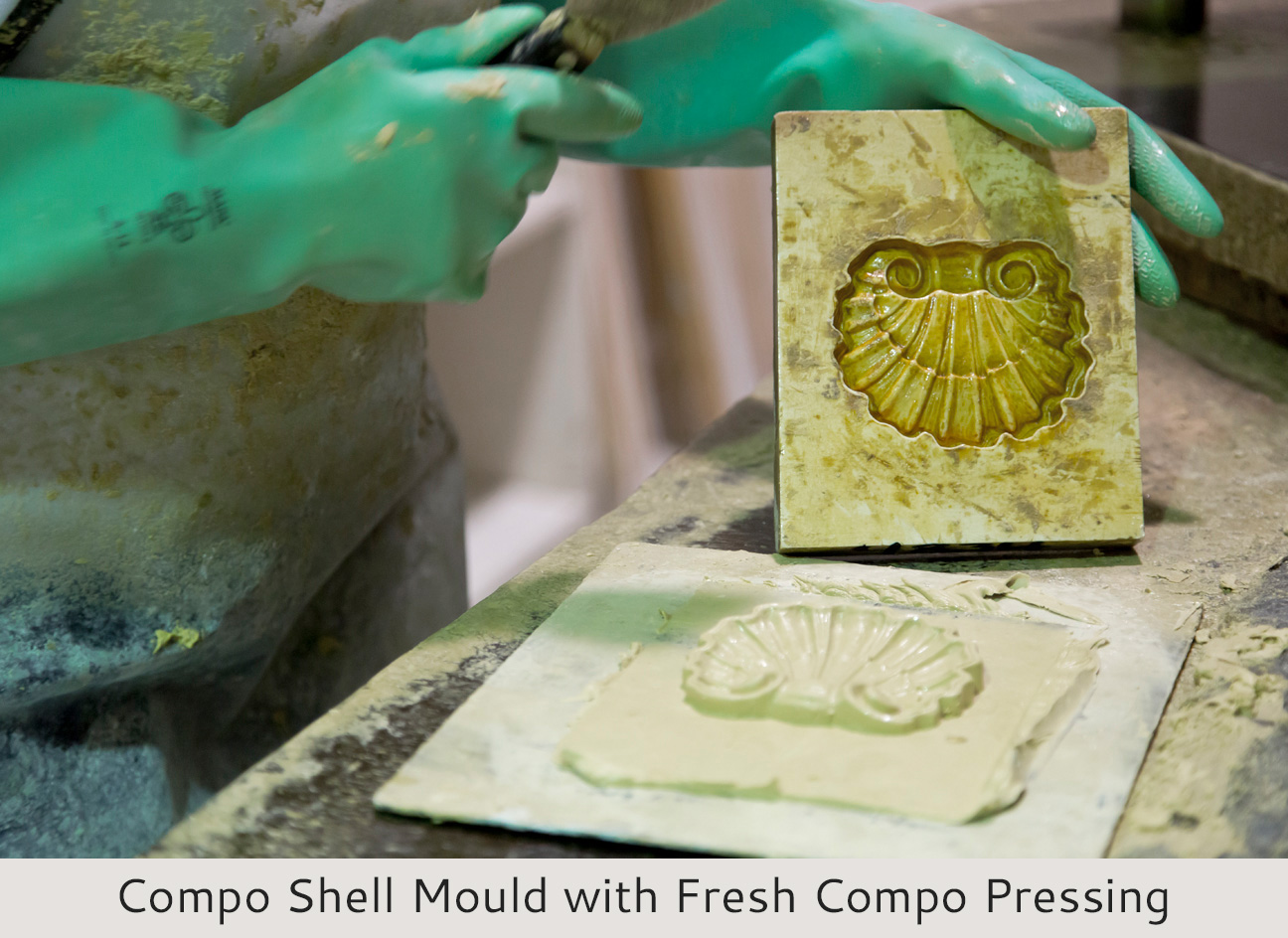 Joseph and Agnes’ timing with their move to Los Angeles was fortuitous. The film industry was drawing the elite from New York’s producers and directors to California’s warm climate, varied terrain, and relatively cheap land, in addition to the avoidance of paying motion picture patent rights to the Thomas Edison Company. Hollywood’s Golden Era was about to commence. And with it, the movie sets were becoming increasingly elaborate, reflecting the era's fascination with Art Deco and other design styles. Studios invested heavily in creating detailed backdrops for both stage productions and elaborate "movie prologues" presented before films. These prologues, a hybrid form of performance, often featured large chorus lines, acrobats, and other performers against elaborate sets. And who better to design and decorate these sets than JP Weaver. Joseph and Agnes had indeed struck California gold.
Joseph and Agnes’ timing with their move to Los Angeles was fortuitous. The film industry was drawing the elite from New York’s producers and directors to California’s warm climate, varied terrain, and relatively cheap land, in addition to the avoidance of paying motion picture patent rights to the Thomas Edison Company. Hollywood’s Golden Era was about to commence. And with it, the movie sets were becoming increasingly elaborate, reflecting the era's fascination with Art Deco and other design styles. Studios invested heavily in creating detailed backdrops for both stage productions and elaborate "movie prologues" presented before films. These prologues, a hybrid form of performance, often featured large chorus lines, acrobats, and other performers against elaborate sets. And who better to design and decorate these sets than JP Weaver. Joseph and Agnes had indeed struck California gold.
 A self made man, Joseph was loath hire help for his business. But as his workload proliferated, it became apparent he was going to need a staff. Joseph had struck up a friendship with a neighbor of his, Robert McKenzie, who happened to have a penchant for plaster and carpentry. Joseph thought of hiring Robert into his business; problem was Robert was about to be shipped off to Europe to fight in World War I. Joseph assured his friend there would be a position for him on his return and after the armistice, Joseph and Robert became partners in the JP Weaver Company. Business boomed and the two took on countless projects including interiors for the burgeoning mansions sprouting from Beverly Hills all the way to the beaches at Santa Monica; this on top of their mainstay income for set design and construction for the major studios. The Roaring Twenties were just that for the JP Weaver Company. Talent and hard work had paid off well for Joseph and Robert.
A self made man, Joseph was loath hire help for his business. But as his workload proliferated, it became apparent he was going to need a staff. Joseph had struck up a friendship with a neighbor of his, Robert McKenzie, who happened to have a penchant for plaster and carpentry. Joseph thought of hiring Robert into his business; problem was Robert was about to be shipped off to Europe to fight in World War I. Joseph assured his friend there would be a position for him on his return and after the armistice, Joseph and Robert became partners in the JP Weaver Company. Business boomed and the two took on countless projects including interiors for the burgeoning mansions sprouting from Beverly Hills all the way to the beaches at Santa Monica; this on top of their mainstay income for set design and construction for the major studios. The Roaring Twenties were just that for the JP Weaver Company. Talent and hard work had paid off well for Joseph and Robert.
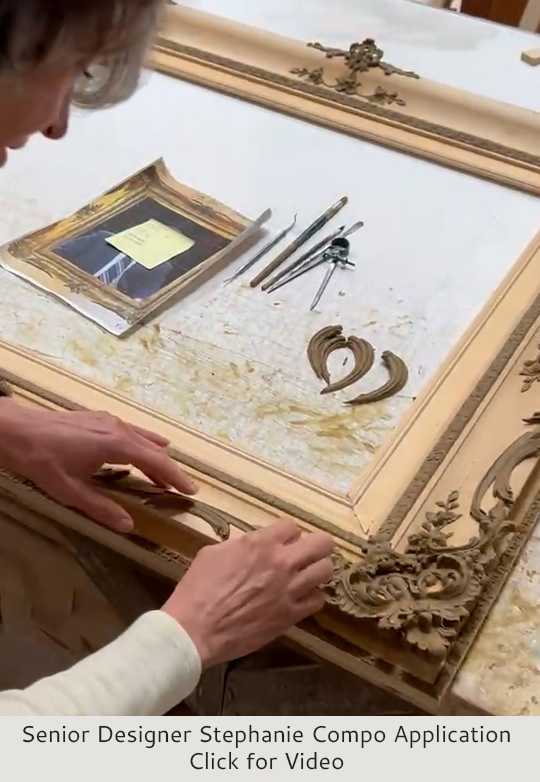 The 1930’s of course ushered in the Great Depression, and with it mass unemployment, bank failures, and a decline in construction spending. This did not prove fatal for JP Weaver Company, but business certainly fell off. Income from the movie industry kept their doors open, yet Joseph and Robert were struggling financially nonetheless. However the company would suffer another blow when Joseph died suddenly in 1936. Now the weight of the company fell squarely on the shoulders of Robert McKenzie. For the next four decades he alone ran the company, curtailing the work for the studios and scaling back the larger commissions. Most of the work during this period was for furniture appliqué with composition ornament in addition to picture frames.
The 1930’s of course ushered in the Great Depression, and with it mass unemployment, bank failures, and a decline in construction spending. This did not prove fatal for JP Weaver Company, but business certainly fell off. Income from the movie industry kept their doors open, yet Joseph and Robert were struggling financially nonetheless. However the company would suffer another blow when Joseph died suddenly in 1936. Now the weight of the company fell squarely on the shoulders of Robert McKenzie. For the next four decades he alone ran the company, curtailing the work for the studios and scaling back the larger commissions. Most of the work during this period was for furniture appliqué with composition ornament in addition to picture frames.
 In the late 1960’s, Lenna Tyler Kast, a naturally gifted designer who developed a fascination with composition ornament, began using ornament from the JP Weaver Company with her son Rob Tyler. Although the company had scaled back considerably from its salad days, Lenna had a grander vision of what could be done with “compo”, and set her plan in motion by slowly buying shares of the company. She had the vision to revive the nearly lost art of producing ornate architectural moulding, reminiscent of the elegance of Versailles. She was successful in acquiring the company in 1980, allowing her to pursue this dream.
In the late 1960’s, Lenna Tyler Kast, a naturally gifted designer who developed a fascination with composition ornament, began using ornament from the JP Weaver Company with her son Rob Tyler. Although the company had scaled back considerably from its salad days, Lenna had a grander vision of what could be done with “compo”, and set her plan in motion by slowly buying shares of the company. She had the vision to revive the nearly lost art of producing ornate architectural moulding, reminiscent of the elegance of Versailles. She was successful in acquiring the company in 1980, allowing her to pursue this dream.
 Within the trade, composition ornament is affectionately refereed to as “compo”, a decorative art medium that is highly flexible and self-bonding to any interior hard surface. It’s an interior decoration that has been all but lost for centuries. Originated in the Early Italian Renaissance, this fine form of relief ornament is ubiquitous in the palaces and châteaux of Europe, and is still used today with furniture, cabinetry, millwork, ceilings and walls. Our proprietary JP Weaver recipe for compo is something of an industry standard as it affords impeccable and exquisite detail while maintaining a pliability and ease of use for installers and designers. Note during installation and application the compo’s pliability affords the opportunity of “bending” the material to achieve wonderful “undercuts”. The (JP Weaver Composition Ornament Handbook) boasts over 10 Thousand remarkably vivid printed photos, pictured in perfect 1/4 scale. This handbook fostered a revolution in ornamental design in that the images, having a true 1/4 scale, offered the designer the ability to copy the pages, then “cut and paste” mock-ups and final designs; a work-flow quite impossible before the printing of this wonderful volume. The handbook is an invaluable addition to any designer’s library. In addition, our Signature Compo line is beautifully displayed on full scale boards in our showroom in Glendale California.
Within the trade, composition ornament is affectionately refereed to as “compo”, a decorative art medium that is highly flexible and self-bonding to any interior hard surface. It’s an interior decoration that has been all but lost for centuries. Originated in the Early Italian Renaissance, this fine form of relief ornament is ubiquitous in the palaces and châteaux of Europe, and is still used today with furniture, cabinetry, millwork, ceilings and walls. Our proprietary JP Weaver recipe for compo is something of an industry standard as it affords impeccable and exquisite detail while maintaining a pliability and ease of use for installers and designers. Note during installation and application the compo’s pliability affords the opportunity of “bending” the material to achieve wonderful “undercuts”. The (JP Weaver Composition Ornament Handbook) boasts over 10 Thousand remarkably vivid printed photos, pictured in perfect 1/4 scale. This handbook fostered a revolution in ornamental design in that the images, having a true 1/4 scale, offered the designer the ability to copy the pages, then “cut and paste” mock-ups and final designs; a work-flow quite impossible before the printing of this wonderful volume. The handbook is an invaluable addition to any designer’s library. In addition, our Signature Compo line is beautifully displayed on full scale boards in our showroom in Glendale California.
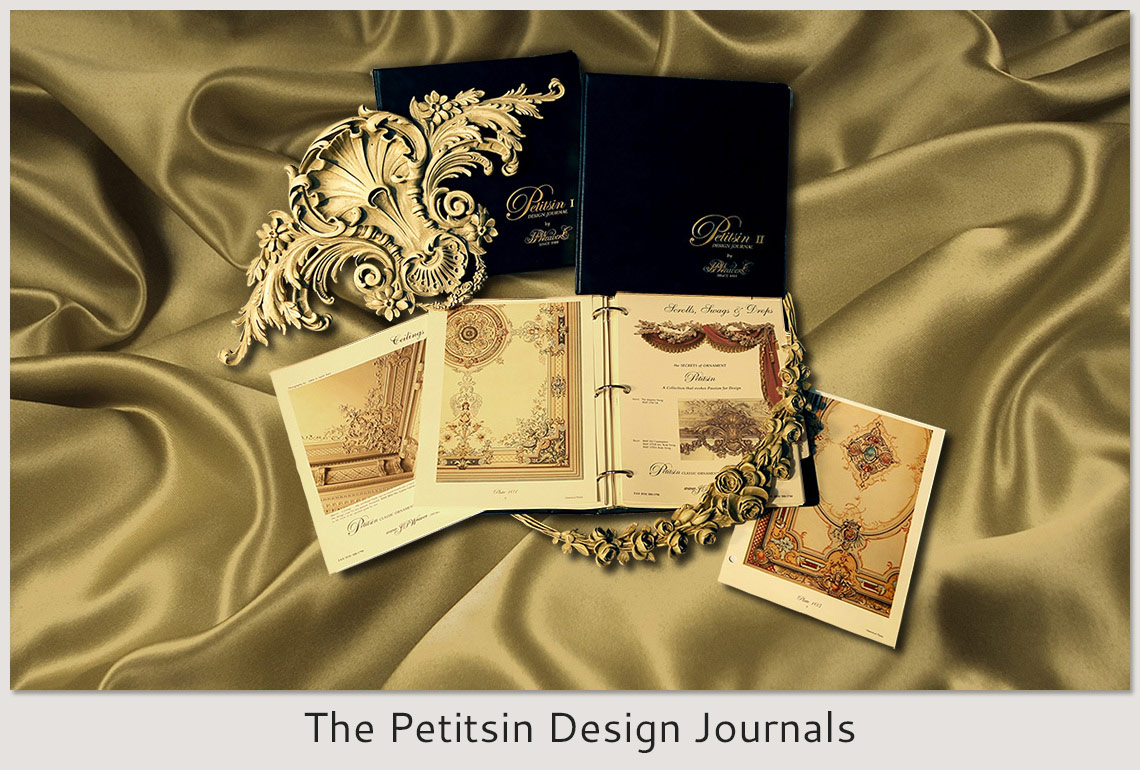 Lenna revitalized the company by cataloging the inventory of models and moulds and compo with beautiful large format photography and created a compendium of ornament. However she faced a challenge with the compo ornamentation: while in and of itself it was an unparalleled design medium, the intricacy and sheer volume of the parts made the creation of larger scaled compositions somewhat daunting for designers. Having an intimate connection with the vast catalog coupled with their design talents, both Lenna and Stephanie set to task the creation of larger composites (panels, wall components, linears and centerpieces) comprised of the compo elements to be made in a far more durable resin material, without any sacrifice of detail. This was the creation of our Signature Petitsin line. In short, it allows designers and installers to create magnificent ornament interior tableaus on a scale which would be quite impractical to do in compo. Once an adequate collection of these pieces were created, Lenna authored ("The Petitsin Design Handbook", still available and in print today), which has become a ubiquitous standard with elite design firms worldwide.
Lenna revitalized the company by cataloging the inventory of models and moulds and compo with beautiful large format photography and created a compendium of ornament. However she faced a challenge with the compo ornamentation: while in and of itself it was an unparalleled design medium, the intricacy and sheer volume of the parts made the creation of larger scaled compositions somewhat daunting for designers. Having an intimate connection with the vast catalog coupled with their design talents, both Lenna and Stephanie set to task the creation of larger composites (panels, wall components, linears and centerpieces) comprised of the compo elements to be made in a far more durable resin material, without any sacrifice of detail. This was the creation of our Signature Petitsin line. In short, it allows designers and installers to create magnificent ornament interior tableaus on a scale which would be quite impractical to do in compo. Once an adequate collection of these pieces were created, Lenna authored ("The Petitsin Design Handbook", still available and in print today), which has become a ubiquitous standard with elite design firms worldwide.
 Lenna got a major break when she won a bid to do restoration work for the California State Capital Building. At this time she enlisted the help of her son Rob Tyler who began to specialize in carving. Later, Lenna would attract the talents of designer Stephanie Croce, a recent graduate from NYU who displayed a magnificent aptitude for design. Lenna fostered Stephanie’s talents in the art and nuances of ornament within interior design, and very quickly Stephanie’s aptitude and skills flourished, constantly discovering both elegant and novel solutions to the design challenges brought in by their newfound clients. Lenna’s step-son Adam Kast, a talented master carpenter, was also brought in to overhaul the company’s plaster cornice crown moulding production. The company’s extant moulds and models were in dismal condition and Adam’s skills were invaluable in revitalizing the plaster catalog, along with fresh and insightful ideas in expanding the collection.
Lenna got a major break when she won a bid to do restoration work for the California State Capital Building. At this time she enlisted the help of her son Rob Tyler who began to specialize in carving. Later, Lenna would attract the talents of designer Stephanie Croce, a recent graduate from NYU who displayed a magnificent aptitude for design. Lenna fostered Stephanie’s talents in the art and nuances of ornament within interior design, and very quickly Stephanie’s aptitude and skills flourished, constantly discovering both elegant and novel solutions to the design challenges brought in by their newfound clients. Lenna’s step-son Adam Kast, a talented master carpenter, was also brought in to overhaul the company’s plaster cornice crown moulding production. The company’s extant moulds and models were in dismal condition and Adam’s skills were invaluable in revitalizing the plaster catalog, along with fresh and insightful ideas in expanding the collection.
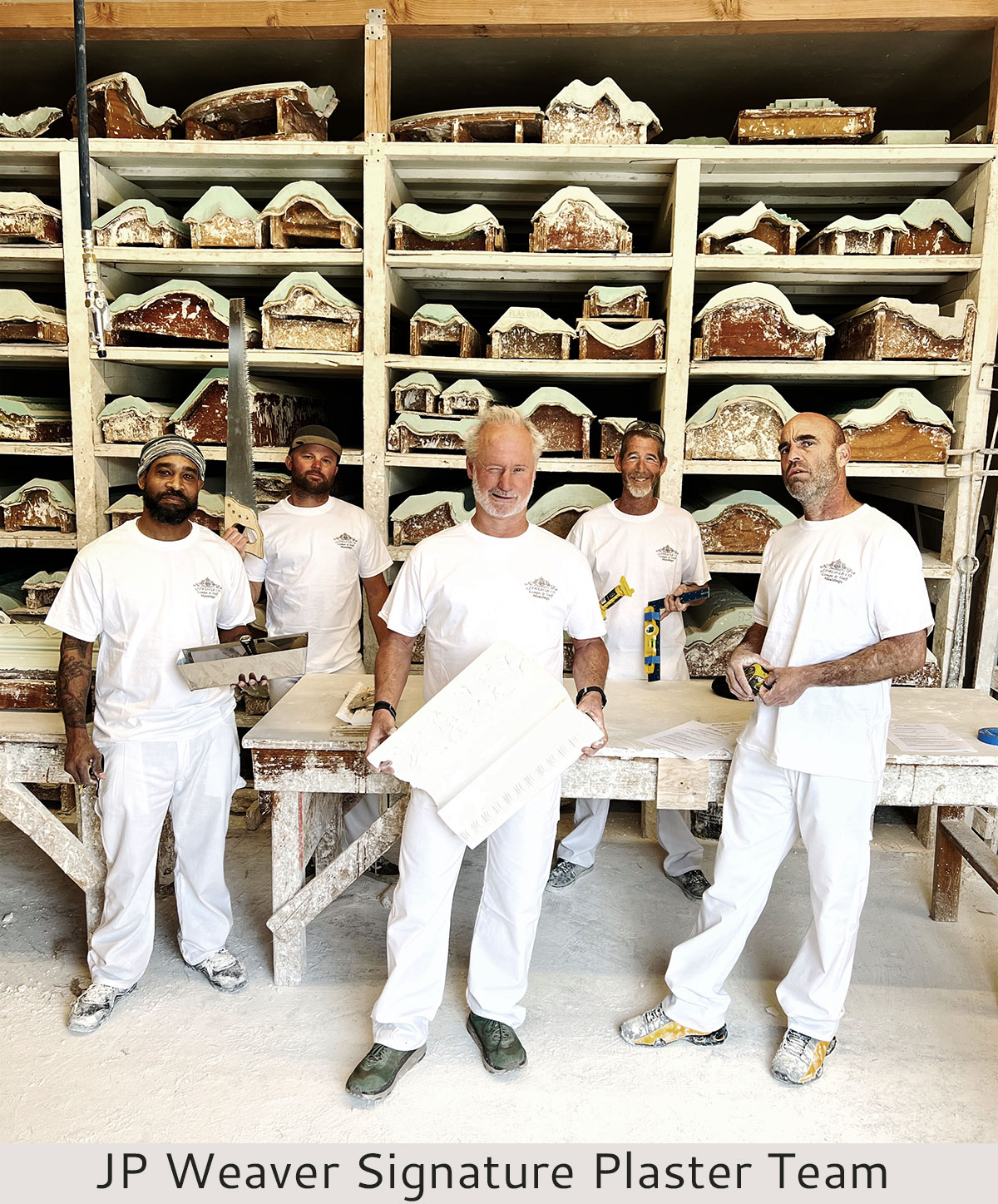 Adam cut his teeth in construction with his father Sam, a successful and master builder in Los Angeles. Sam Kast was wonderfully adept at a myriad of trades, including masonry, carpentry, painting, tile work; virtually every skill set required to build a home on any scale. As a teenager, Adam worked shoulder to shoulder with his father, and the father’s talents were passed forward. Sam’s work ethic was one of perfection, and this dedication was not lost on the son. So when the need arose to revitalize and expand the JP Weaver Signature plaster line, Adam became the perfect fit. The extant moulds and models were in very poor condition and a craftsman’s eye and hand was critically needed for this arm of the company. Adam set to task the creation of new moulds with “trued” fiberglass cases in concert with superior silicone products to produce impeccable castings with unrivaled detail and superb quality. Adam continues to oversee all aspects of the JP Weaver Signature Plaster line, including all custom work and restoration projects. His efforts have placed the plaster arm of JP Weaver in the top echelon of ornamental staff work.
Adam cut his teeth in construction with his father Sam, a successful and master builder in Los Angeles. Sam Kast was wonderfully adept at a myriad of trades, including masonry, carpentry, painting, tile work; virtually every skill set required to build a home on any scale. As a teenager, Adam worked shoulder to shoulder with his father, and the father’s talents were passed forward. Sam’s work ethic was one of perfection, and this dedication was not lost on the son. So when the need arose to revitalize and expand the JP Weaver Signature plaster line, Adam became the perfect fit. The extant moulds and models were in very poor condition and a craftsman’s eye and hand was critically needed for this arm of the company. Adam set to task the creation of new moulds with “trued” fiberglass cases in concert with superior silicone products to produce impeccable castings with unrivaled detail and superb quality. Adam continues to oversee all aspects of the JP Weaver Signature Plaster line, including all custom work and restoration projects. His efforts have placed the plaster arm of JP Weaver in the top echelon of ornamental staff work.
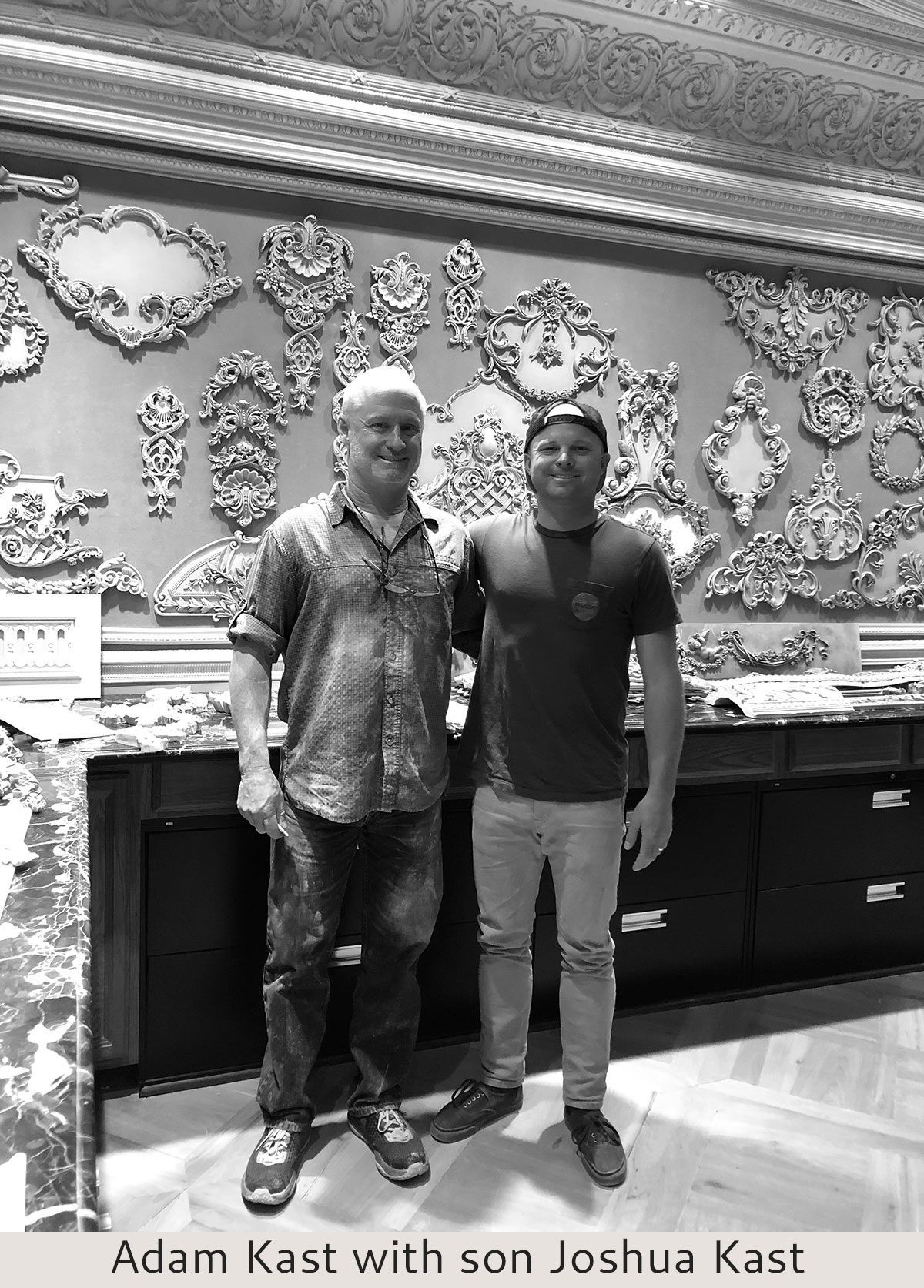 You could say that one of the bywords of JP Weaver Company would be heritage. True to this form, Adam (recognizing similar familial talents within his son Joshua) brought his boy to work, just as his father did. Josh’s aptitude was at once evident, and it was not long before his talents blossomed in many aspects of the business; not the least of which, design. Working closely with JP Weaver Senior Designer Stephanie Croce, Josh quickly developed a penchant for forms and design flow with ornamentation. He was in the vanguard of JP Weaver’s adoption of CAD drawing and design in the early 2000’s. Since then he has become one of JP Weaver’s lead designers, working along with Angela Isayan (another eminent designer at JP Weaver), under design lead Stephanie Croce. This triumvirate has become the core of the design arm of JP Weaver: the Signature Design Service. Unlike any other entity within the industry, this service facilitates our clients visions and ideas (regardless of how small or grand) and nurtures them into creations of interior ornamentation that have graced the pages of premier design journals and monographs internationally. Yet most importantly, the Signature Design Service yields the client a manifestation of their own unique vision, in scaled drawings, impeccably detailed.
You could say that one of the bywords of JP Weaver Company would be heritage. True to this form, Adam (recognizing similar familial talents within his son Joshua) brought his boy to work, just as his father did. Josh’s aptitude was at once evident, and it was not long before his talents blossomed in many aspects of the business; not the least of which, design. Working closely with JP Weaver Senior Designer Stephanie Croce, Josh quickly developed a penchant for forms and design flow with ornamentation. He was in the vanguard of JP Weaver’s adoption of CAD drawing and design in the early 2000’s. Since then he has become one of JP Weaver’s lead designers, working along with Angela Isayan (another eminent designer at JP Weaver), under design lead Stephanie Croce. This triumvirate has become the core of the design arm of JP Weaver: the Signature Design Service. Unlike any other entity within the industry, this service facilitates our clients visions and ideas (regardless of how small or grand) and nurtures them into creations of interior ornamentation that have graced the pages of premier design journals and monographs internationally. Yet most importantly, the Signature Design Service yields the client a manifestation of their own unique vision, in scaled drawings, impeccably detailed.
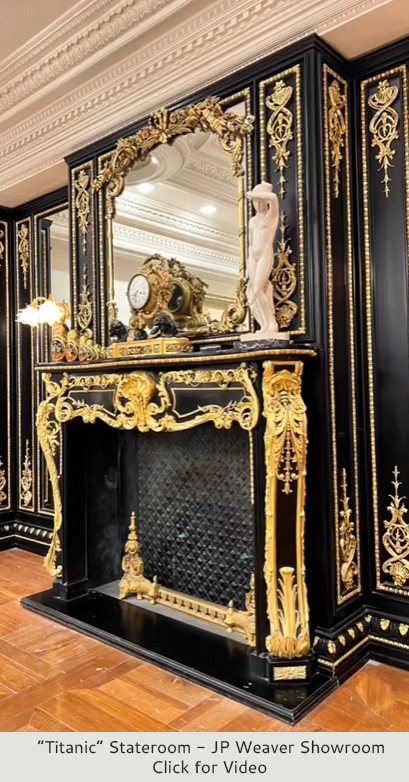 As the JP Weaver Signature Design Service was launched, a most interesting project came or way. The movie “Titanic” was in pre-production, and the scope of the film was quite ambitions to say the least. A near full-scale replica of the ship needed to be built and would be constructed in a massive water tank in Mexico. It took seven months to build, and the ship was broken into sections to allow for filming from different angles during the sinking sequence. The film’s production team had obtained archived drawings of the state rooms and approached us to make the sets for what would become the walls of these rooms. There were however several mandates. Among them, they of course had to be as accurate as possible, impeccably detailed, exquisitely beautiful, and oh yes… submersible in water. That was a new one for us. Fortunately the timing was fortuitous as we were establishing our Signature Petitsin Line (a proprietary resin-based ornament) virtually impervious to water. As most Hollywood projects, deadlines were set and production was under the gun. Within weeks of the initial meeting, the JP Weaver Signature Design Service created scaled drawings for the production team along with all of the parts necessary to create all the set design. Those of you who have seen the film know how it turned out. "Titanic" won the Academy Award for Art Direction and Set Decoration, a category now known as Best Production Design, for its work on the film. Many have looked upon the ship and it’s embellishments as something of a character themselves within the film. We have also recreated this stateroom in our showroom here in Glendale California. The room has become something of a favorite for our clients and oftentimes we’ll collaborate in-house with them on their projects in the “Titanic Stateroom”.
As the JP Weaver Signature Design Service was launched, a most interesting project came or way. The movie “Titanic” was in pre-production, and the scope of the film was quite ambitions to say the least. A near full-scale replica of the ship needed to be built and would be constructed in a massive water tank in Mexico. It took seven months to build, and the ship was broken into sections to allow for filming from different angles during the sinking sequence. The film’s production team had obtained archived drawings of the state rooms and approached us to make the sets for what would become the walls of these rooms. There were however several mandates. Among them, they of course had to be as accurate as possible, impeccably detailed, exquisitely beautiful, and oh yes… submersible in water. That was a new one for us. Fortunately the timing was fortuitous as we were establishing our Signature Petitsin Line (a proprietary resin-based ornament) virtually impervious to water. As most Hollywood projects, deadlines were set and production was under the gun. Within weeks of the initial meeting, the JP Weaver Signature Design Service created scaled drawings for the production team along with all of the parts necessary to create all the set design. Those of you who have seen the film know how it turned out. "Titanic" won the Academy Award for Art Direction and Set Decoration, a category now known as Best Production Design, for its work on the film. Many have looked upon the ship and it’s embellishments as something of a character themselves within the film. We have also recreated this stateroom in our showroom here in Glendale California. The room has become something of a favorite for our clients and oftentimes we’ll collaborate in-house with them on their projects in the “Titanic Stateroom”.
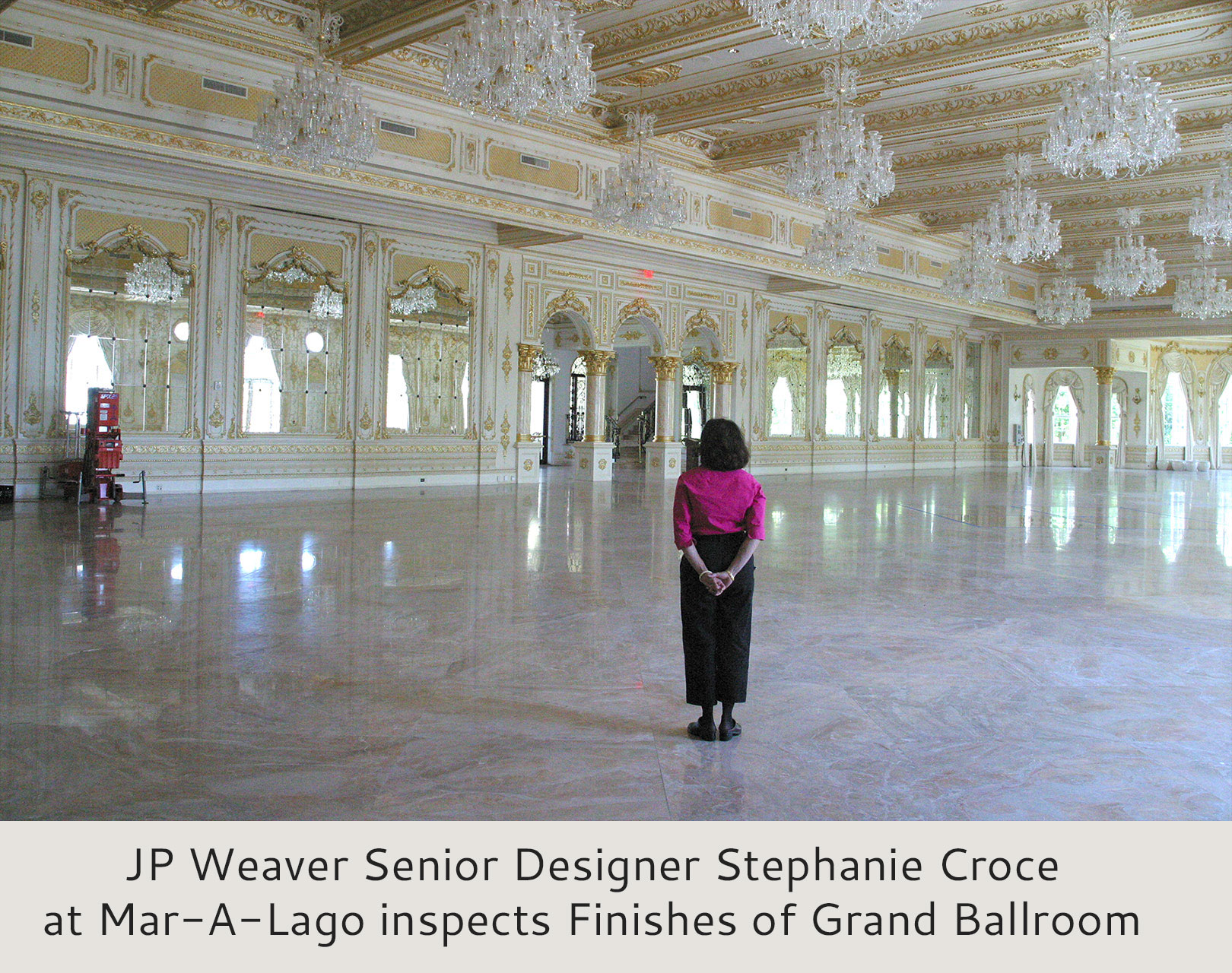 It was not long after this another interesting project crossed our drawing boards. Mar-A-Lago, the iconic property in Palm Beach Florida, was to have a complete and extensive renovation. The scope of this property bears mentioning; The name Mar-a-Lago means "sea to lake" in Spanish, reflecting the fact that the estate extends from one end of Palm Beach Island to the other, touching the Atlantic Ocean on the east and the Lake Worth Lagoon on the west. It was built during the 1920s Florida land boom for Marjorie Merriweather Post, heiress to the Post Cereals business and later the wealthiest woman in the United States. Post spent US $7 million (equivalent to $127 million in 2024) and the estate was finished in 1927. At the time it was the most expensive non-royal residence built in history. The heiress originally hired Sims Wyeth as designer and Joseph Urban for for the marvelous interiors, but the current renovation of Mar-A-Lago included a ballroom unlike any other in existence. Measuring 200 feet in length, 100 feet in width (2/3 the size of a football field) with 27 foot high ceilings, the magnificent space would hold court to some of the grandest fêtes in America. JP Weaver Senior Stephanie Croce set to task what would become the design and drawings for this impressive space. “I never set foot inside the room until after all the finishes were done,” says Stephanie. “I won’t lie and say the sheer size of the project was not daunting, but trusting my gut instincts and talents have always stayed my course regardless of the project’s scope.” Stephanie’s results yielded what has become one of the crown jewels of our Signature Design Service; a resplendent room that has become the heart of the re-environed estate of Mar-A-Lago.
It was not long after this another interesting project crossed our drawing boards. Mar-A-Lago, the iconic property in Palm Beach Florida, was to have a complete and extensive renovation. The scope of this property bears mentioning; The name Mar-a-Lago means "sea to lake" in Spanish, reflecting the fact that the estate extends from one end of Palm Beach Island to the other, touching the Atlantic Ocean on the east and the Lake Worth Lagoon on the west. It was built during the 1920s Florida land boom for Marjorie Merriweather Post, heiress to the Post Cereals business and later the wealthiest woman in the United States. Post spent US $7 million (equivalent to $127 million in 2024) and the estate was finished in 1927. At the time it was the most expensive non-royal residence built in history. The heiress originally hired Sims Wyeth as designer and Joseph Urban for for the marvelous interiors, but the current renovation of Mar-A-Lago included a ballroom unlike any other in existence. Measuring 200 feet in length, 100 feet in width (2/3 the size of a football field) with 27 foot high ceilings, the magnificent space would hold court to some of the grandest fêtes in America. JP Weaver Senior Stephanie Croce set to task what would become the design and drawings for this impressive space. “I never set foot inside the room until after all the finishes were done,” says Stephanie. “I won’t lie and say the sheer size of the project was not daunting, but trusting my gut instincts and talents have always stayed my course regardless of the project’s scope.” Stephanie’s results yielded what has become one of the crown jewels of our Signature Design Service; a resplendent room that has become the heart of the re-environed estate of Mar-A-Lago.
 In 1993 JP Weaver moved into its current home at 941 Air Way in Glendale, California, where it’s become established as the international standard for the design and making of interior ornamental and plaster mouldings. In 2023 we sadly lost the company’s matriarch Lenna Tyler Kast at the age of 93. Her hard work and passion forever imbued in the company’s ethos. And now the next generation of JP Weaver, President Robert T. Tyler, Senior Designer Stephanie Croce, and Project Supervisor Adam Kast, carries the torch forward for the next chapter of it’s legacy.
In 1993 JP Weaver moved into its current home at 941 Air Way in Glendale, California, where it’s become established as the international standard for the design and making of interior ornamental and plaster mouldings. In 2023 we sadly lost the company’s matriarch Lenna Tyler Kast at the age of 93. Her hard work and passion forever imbued in the company’s ethos. And now the next generation of JP Weaver, President Robert T. Tyler, Senior Designer Stephanie Croce, and Project Supervisor Adam Kast, carries the torch forward for the next chapter of it’s legacy.

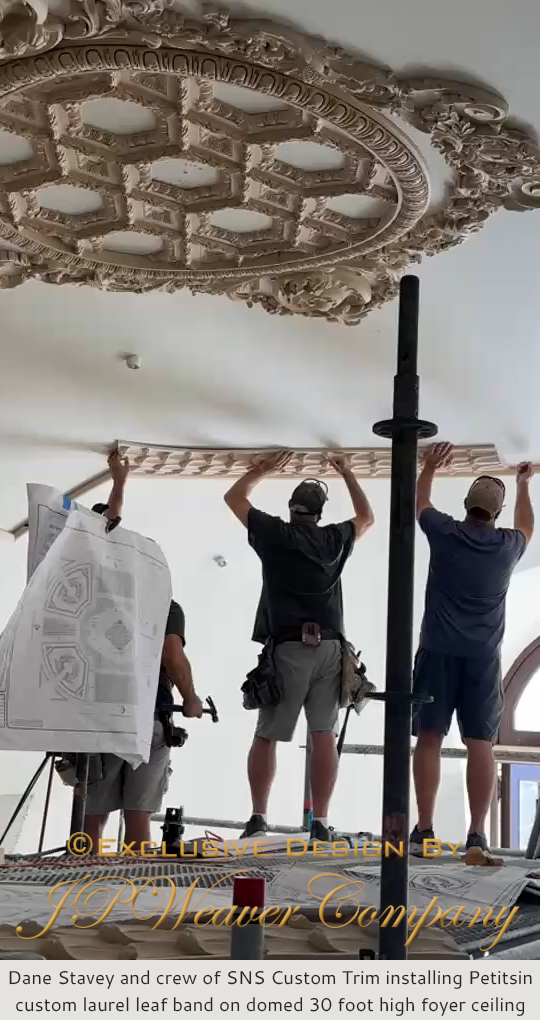
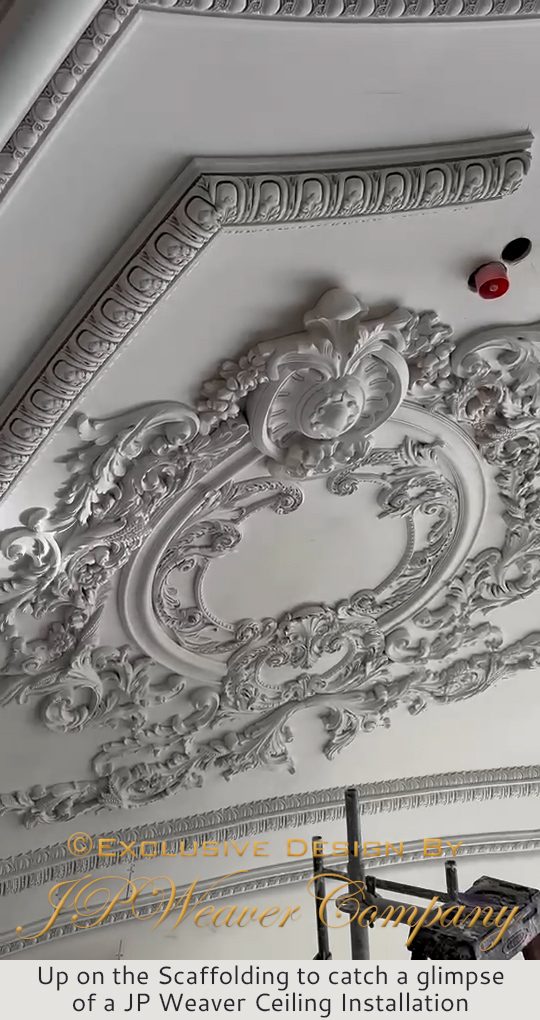



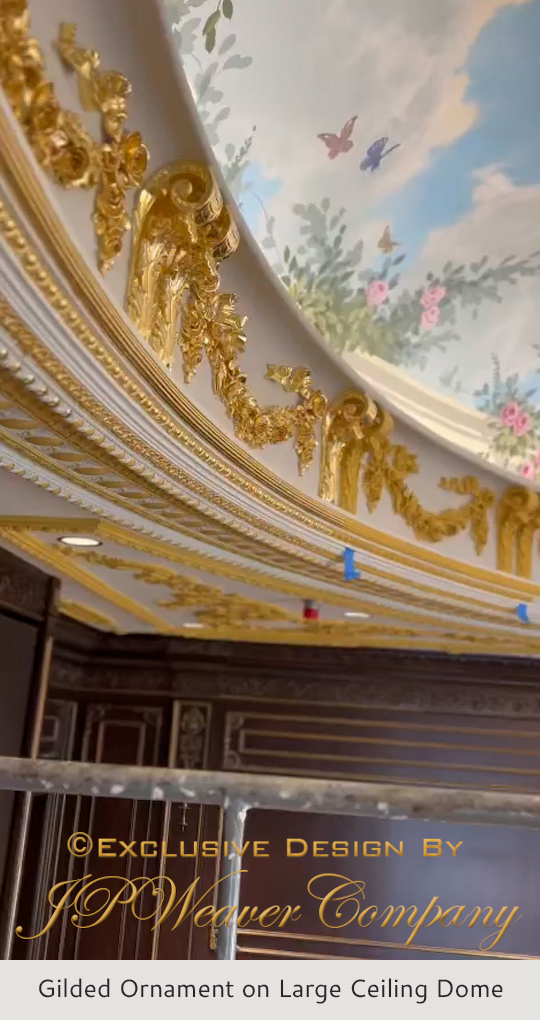

 JP Weaver’s origins began in the late 19th century when 18-year-old Joseph Pearce Weaver founded his eponymous business in West Derby, Lancashire County, England. His father George was a master carver and gilder under who’s tutelage Joseph’s craft was honed. Numerous ecclesiastical and public projects imbued father and son with a reputation of “most excellent and brilliant workmanship.” After his father’s illness, Joseph threw himself headlong into his small local business, and soon the young man found himself taking on much larger commissions throughout greater London. In 1886 when Joseph turned 20, the same year the Statue of Liberty was officially dedicated in New York Harbor, the allure of living and working in the United States with its magnificent prospects and opportunities drew him across the Atlantic.
JP Weaver’s origins began in the late 19th century when 18-year-old Joseph Pearce Weaver founded his eponymous business in West Derby, Lancashire County, England. His father George was a master carver and gilder under who’s tutelage Joseph’s craft was honed. Numerous ecclesiastical and public projects imbued father and son with a reputation of “most excellent and brilliant workmanship.” After his father’s illness, Joseph threw himself headlong into his small local business, and soon the young man found himself taking on much larger commissions throughout greater London. In 1886 when Joseph turned 20, the same year the Statue of Liberty was officially dedicated in New York Harbor, the allure of living and working in the United States with its magnificent prospects and opportunities drew him across the Atlantic.
 Joseph found fertile ground for business in “The Colonies” and was very quickly in much demand with commissions and projects amidst the halcyon of America’s gilded age. During this time, he met and married the woman who would become his lifelong companion, blue blood and socialite Agnes E. Burns. By the early 1900’s, Los Angeles was experiencing a significant business boom, fueled by agricultural industries, particularly citrus fruits, and the opening of the Panama Canal. The city was also home to early banking institutions, like the Bank of Italy (precursor to Bank of America), which was facilitating business and prodigious growth. Also, filmmakers were beginning to move to Los Angeles to avoid legal challenges related to patents for motion picture equipment. Ever the wanderlust, Joseph brought his wife Agnes to Los Angeles to pursue the “California Dream”, formally listing his business in 1914 as JP Weaver Company.
Joseph found fertile ground for business in “The Colonies” and was very quickly in much demand with commissions and projects amidst the halcyon of America’s gilded age. During this time, he met and married the woman who would become his lifelong companion, blue blood and socialite Agnes E. Burns. By the early 1900’s, Los Angeles was experiencing a significant business boom, fueled by agricultural industries, particularly citrus fruits, and the opening of the Panama Canal. The city was also home to early banking institutions, like the Bank of Italy (precursor to Bank of America), which was facilitating business and prodigious growth. Also, filmmakers were beginning to move to Los Angeles to avoid legal challenges related to patents for motion picture equipment. Ever the wanderlust, Joseph brought his wife Agnes to Los Angeles to pursue the “California Dream”, formally listing his business in 1914 as JP Weaver Company.
 Joseph and Agnes’ timing with their move to Los Angeles was fortuitous. The film industry was drawing the elite from New York’s producers and directors to California’s warm climate, varied terrain, and relatively cheap land, in addition to the avoidance of paying motion picture patent rights to the Thomas Edison Company. Hollywood’s Golden Era was about to commence. And with it, the movie sets were becoming increasingly elaborate, reflecting the era's fascination with Art Deco and other design styles. Studios invested heavily in creating detailed backdrops for both stage productions and elaborate "movie prologues" presented before films. These prologues, a hybrid form of performance, often featured large chorus lines, acrobats, and other performers against elaborate sets. And who better to design and decorate these sets than JP Weaver. Joseph and Agnes had indeed struck California gold.
Joseph and Agnes’ timing with their move to Los Angeles was fortuitous. The film industry was drawing the elite from New York’s producers and directors to California’s warm climate, varied terrain, and relatively cheap land, in addition to the avoidance of paying motion picture patent rights to the Thomas Edison Company. Hollywood’s Golden Era was about to commence. And with it, the movie sets were becoming increasingly elaborate, reflecting the era's fascination with Art Deco and other design styles. Studios invested heavily in creating detailed backdrops for both stage productions and elaborate "movie prologues" presented before films. These prologues, a hybrid form of performance, often featured large chorus lines, acrobats, and other performers against elaborate sets. And who better to design and decorate these sets than JP Weaver. Joseph and Agnes had indeed struck California gold.  A self made man, Joseph was loath hire help for his business. But as his workload proliferated, it became apparent he was going to need a staff. Joseph had struck up a friendship with a neighbor of his, Robert McKenzie, who happened to have a penchant for plaster and carpentry. Joseph thought of hiring Robert into his business; problem was Robert was about to be shipped off to Europe to fight in World War I. Joseph assured his friend there would be a position for him on his return and after the armistice, Joseph and Robert became partners in the JP Weaver Company. Business boomed and the two took on countless projects including interiors for the burgeoning mansions sprouting from Beverly Hills all the way to the beaches at Santa Monica; this on top of their mainstay income for set design and construction for the major studios. The Roaring Twenties were just that for the JP Weaver Company. Talent and hard work had paid off well for Joseph and Robert.
A self made man, Joseph was loath hire help for his business. But as his workload proliferated, it became apparent he was going to need a staff. Joseph had struck up a friendship with a neighbor of his, Robert McKenzie, who happened to have a penchant for plaster and carpentry. Joseph thought of hiring Robert into his business; problem was Robert was about to be shipped off to Europe to fight in World War I. Joseph assured his friend there would be a position for him on his return and after the armistice, Joseph and Robert became partners in the JP Weaver Company. Business boomed and the two took on countless projects including interiors for the burgeoning mansions sprouting from Beverly Hills all the way to the beaches at Santa Monica; this on top of their mainstay income for set design and construction for the major studios. The Roaring Twenties were just that for the JP Weaver Company. Talent and hard work had paid off well for Joseph and Robert.
 The 1930’s of course ushered in the Great Depression, and with it mass unemployment, bank failures, and a decline in construction spending. This did not prove fatal for JP Weaver Company, but business certainly fell off. Income from the movie industry kept their doors open, yet Joseph and Robert were struggling financially nonetheless. However the company would suffer another blow when Joseph died suddenly in 1936. Now the weight of the company fell squarely on the shoulders of Robert McKenzie. For the next four decades he alone ran the company, curtailing the work for the studios and scaling back the larger commissions. Most of the work during this period was for furniture appliqué with composition ornament in addition to picture frames.
The 1930’s of course ushered in the Great Depression, and with it mass unemployment, bank failures, and a decline in construction spending. This did not prove fatal for JP Weaver Company, but business certainly fell off. Income from the movie industry kept their doors open, yet Joseph and Robert were struggling financially nonetheless. However the company would suffer another blow when Joseph died suddenly in 1936. Now the weight of the company fell squarely on the shoulders of Robert McKenzie. For the next four decades he alone ran the company, curtailing the work for the studios and scaling back the larger commissions. Most of the work during this period was for furniture appliqué with composition ornament in addition to picture frames.
 In the late 1960’s, Lenna Tyler Kast, a naturally gifted designer who developed a fascination with composition ornament, began using ornament from the JP Weaver Company with her son Rob Tyler. Although the company had scaled back considerably from its salad days, Lenna had a grander vision of what could be done with “compo”, and set her plan in motion by slowly buying shares of the company. She had the vision to revive the nearly lost art of producing ornate architectural moulding, reminiscent of the elegance of Versailles. She was successful in acquiring the company in 1980, allowing her to pursue this dream.
In the late 1960’s, Lenna Tyler Kast, a naturally gifted designer who developed a fascination with composition ornament, began using ornament from the JP Weaver Company with her son Rob Tyler. Although the company had scaled back considerably from its salad days, Lenna had a grander vision of what could be done with “compo”, and set her plan in motion by slowly buying shares of the company. She had the vision to revive the nearly lost art of producing ornate architectural moulding, reminiscent of the elegance of Versailles. She was successful in acquiring the company in 1980, allowing her to pursue this dream.
 Within the trade, composition ornament is affectionately refereed to as “compo”, a decorative art medium that is highly flexible and self-bonding to any interior hard surface. It’s an interior decoration that has been all but lost for centuries. Originated in the Early Italian Renaissance, this fine form of relief ornament is ubiquitous in the palaces and châteaux of Europe, and is still used today with furniture, cabinetry, millwork, ceilings and walls. Our proprietary JP Weaver recipe for compo is something of an industry standard as it affords impeccable and exquisite detail while maintaining a pliability and ease of use for installers and designers. Note during installation and application the compo’s pliability affords the opportunity of “bending” the material to achieve wonderful “undercuts”. The (JP Weaver Composition Ornament Handbook) boasts over 10 Thousand remarkably vivid printed photos, pictured in perfect 1/4 scale. This handbook fostered a revolution in ornamental design in that the images, having a true 1/4 scale, offered the designer the ability to copy the pages, then “cut and paste” mock-ups and final designs; a work-flow quite impossible before the printing of this wonderful volume. The handbook is an invaluable addition to any designer’s library. In addition, our Signature Compo line is beautifully displayed on full scale boards in our showroom in Glendale California.
Within the trade, composition ornament is affectionately refereed to as “compo”, a decorative art medium that is highly flexible and self-bonding to any interior hard surface. It’s an interior decoration that has been all but lost for centuries. Originated in the Early Italian Renaissance, this fine form of relief ornament is ubiquitous in the palaces and châteaux of Europe, and is still used today with furniture, cabinetry, millwork, ceilings and walls. Our proprietary JP Weaver recipe for compo is something of an industry standard as it affords impeccable and exquisite detail while maintaining a pliability and ease of use for installers and designers. Note during installation and application the compo’s pliability affords the opportunity of “bending” the material to achieve wonderful “undercuts”. The (JP Weaver Composition Ornament Handbook) boasts over 10 Thousand remarkably vivid printed photos, pictured in perfect 1/4 scale. This handbook fostered a revolution in ornamental design in that the images, having a true 1/4 scale, offered the designer the ability to copy the pages, then “cut and paste” mock-ups and final designs; a work-flow quite impossible before the printing of this wonderful volume. The handbook is an invaluable addition to any designer’s library. In addition, our Signature Compo line is beautifully displayed on full scale boards in our showroom in Glendale California.
 Lenna revitalized the company by cataloging the inventory of models and moulds and compo with beautiful large format photography and created a compendium of ornament. However she faced a challenge with the compo ornamentation: while in and of itself it was an unparalleled design medium, the intricacy and sheer volume of the parts made the creation of larger scaled compositions somewhat daunting for designers. Having an intimate connection with the vast catalog coupled with their design talents, both Lenna and Stephanie set to task the creation of larger composites (panels, wall components, linears and centerpieces) comprised of the compo elements to be made in a far more durable resin material, without any sacrifice of detail. This was the creation of our Signature Petitsin line. In short, it allows designers and installers to create magnificent ornament interior tableaus on a scale which would be quite impractical to do in compo. Once an adequate collection of these pieces were created, Lenna authored ("The Petitsin Design Handbook", still available and in print today), which has become a ubiquitous standard with elite design firms worldwide.
Lenna revitalized the company by cataloging the inventory of models and moulds and compo with beautiful large format photography and created a compendium of ornament. However she faced a challenge with the compo ornamentation: while in and of itself it was an unparalleled design medium, the intricacy and sheer volume of the parts made the creation of larger scaled compositions somewhat daunting for designers. Having an intimate connection with the vast catalog coupled with their design talents, both Lenna and Stephanie set to task the creation of larger composites (panels, wall components, linears and centerpieces) comprised of the compo elements to be made in a far more durable resin material, without any sacrifice of detail. This was the creation of our Signature Petitsin line. In short, it allows designers and installers to create magnificent ornament interior tableaus on a scale which would be quite impractical to do in compo. Once an adequate collection of these pieces were created, Lenna authored ("The Petitsin Design Handbook", still available and in print today), which has become a ubiquitous standard with elite design firms worldwide.
 Lenna got a major break when she won a bid to do restoration work for the California State Capital Building. At this time she enlisted the help of her son Rob Tyler who began to specialize in carving. Later, Lenna would attract the talents of designer Stephanie Croce, a recent graduate from NYU who displayed a magnificent aptitude for design. Lenna fostered Stephanie’s talents in the art and nuances of ornament within interior design, and very quickly Stephanie’s aptitude and skills flourished, constantly discovering both elegant and novel solutions to the design challenges brought in by their newfound clients. Lenna’s step-son Adam Kast, a talented master carpenter, was also brought in to overhaul the company’s plaster cornice crown moulding production. The company’s extant moulds and models were in dismal condition and Adam’s skills were invaluable in revitalizing the plaster catalog, along with fresh and insightful ideas in expanding the collection.
Lenna got a major break when she won a bid to do restoration work for the California State Capital Building. At this time she enlisted the help of her son Rob Tyler who began to specialize in carving. Later, Lenna would attract the talents of designer Stephanie Croce, a recent graduate from NYU who displayed a magnificent aptitude for design. Lenna fostered Stephanie’s talents in the art and nuances of ornament within interior design, and very quickly Stephanie’s aptitude and skills flourished, constantly discovering both elegant and novel solutions to the design challenges brought in by their newfound clients. Lenna’s step-son Adam Kast, a talented master carpenter, was also brought in to overhaul the company’s plaster cornice crown moulding production. The company’s extant moulds and models were in dismal condition and Adam’s skills were invaluable in revitalizing the plaster catalog, along with fresh and insightful ideas in expanding the collection.
 Adam cut his teeth in construction with his father Sam, a successful and master builder in Los Angeles. Sam Kast was wonderfully adept at a myriad of trades, including masonry, carpentry, painting, tile work; virtually every skill set required to build a home on any scale. As a teenager, Adam worked shoulder to shoulder with his father, and the father’s talents were passed forward. Sam’s work ethic was one of perfection, and this dedication was not lost on the son. So when the need arose to revitalize and expand the JP Weaver Signature plaster line, Adam became the perfect fit. The extant moulds and models were in very poor condition and a craftsman’s eye and hand was critically needed for this arm of the company. Adam set to task the creation of new moulds with “trued” fiberglass cases in concert with superior silicone products to produce impeccable castings with unrivaled detail and superb quality. Adam continues to oversee all aspects of the JP Weaver Signature Plaster line, including all custom work and restoration projects. His efforts have placed the plaster arm of JP Weaver in the top echelon of ornamental staff work.
Adam cut his teeth in construction with his father Sam, a successful and master builder in Los Angeles. Sam Kast was wonderfully adept at a myriad of trades, including masonry, carpentry, painting, tile work; virtually every skill set required to build a home on any scale. As a teenager, Adam worked shoulder to shoulder with his father, and the father’s talents were passed forward. Sam’s work ethic was one of perfection, and this dedication was not lost on the son. So when the need arose to revitalize and expand the JP Weaver Signature plaster line, Adam became the perfect fit. The extant moulds and models were in very poor condition and a craftsman’s eye and hand was critically needed for this arm of the company. Adam set to task the creation of new moulds with “trued” fiberglass cases in concert with superior silicone products to produce impeccable castings with unrivaled detail and superb quality. Adam continues to oversee all aspects of the JP Weaver Signature Plaster line, including all custom work and restoration projects. His efforts have placed the plaster arm of JP Weaver in the top echelon of ornamental staff work.
 You could say that one of the bywords of JP Weaver Company would be heritage. True to this form, Adam (recognizing similar familial talents within his son Joshua) brought his boy to work, just as his father did. Josh’s aptitude was at once evident, and it was not long before his talents blossomed in many aspects of the business; not the least of which, design. Working closely with JP Weaver Senior Designer Stephanie Croce, Josh quickly developed a penchant for forms and design flow with ornamentation. He was in the vanguard of JP Weaver’s adoption of CAD drawing and design in the early 2000’s. Since then he has become one of JP Weaver’s lead designers, working along with Angela Isayan (another eminent designer at JP Weaver), under design lead Stephanie Croce. This triumvirate has become the core of the design arm of JP Weaver: the Signature Design Service. Unlike any other entity within the industry, this service facilitates our clients visions and ideas (regardless of how small or grand) and nurtures them into creations of interior ornamentation that have graced the pages of premier design journals and monographs internationally. Yet most importantly, the Signature Design Service yields the client a manifestation of their own unique vision, in scaled drawings, impeccably detailed.
You could say that one of the bywords of JP Weaver Company would be heritage. True to this form, Adam (recognizing similar familial talents within his son Joshua) brought his boy to work, just as his father did. Josh’s aptitude was at once evident, and it was not long before his talents blossomed in many aspects of the business; not the least of which, design. Working closely with JP Weaver Senior Designer Stephanie Croce, Josh quickly developed a penchant for forms and design flow with ornamentation. He was in the vanguard of JP Weaver’s adoption of CAD drawing and design in the early 2000’s. Since then he has become one of JP Weaver’s lead designers, working along with Angela Isayan (another eminent designer at JP Weaver), under design lead Stephanie Croce. This triumvirate has become the core of the design arm of JP Weaver: the Signature Design Service. Unlike any other entity within the industry, this service facilitates our clients visions and ideas (regardless of how small or grand) and nurtures them into creations of interior ornamentation that have graced the pages of premier design journals and monographs internationally. Yet most importantly, the Signature Design Service yields the client a manifestation of their own unique vision, in scaled drawings, impeccably detailed.
 As the JP Weaver Signature Design Service was launched, a most interesting project came or way. The movie “Titanic” was in pre-production, and the scope of the film was quite ambitions to say the least. A near full-scale replica of the ship needed to be built and would be constructed in a massive water tank in Mexico. It took seven months to build, and the ship was broken into sections to allow for filming from different angles during the sinking sequence. The film’s production team had obtained archived drawings of the state rooms and approached us to make the sets for what would become the walls of these rooms. There were however several mandates. Among them, they of course had to be as accurate as possible, impeccably detailed, exquisitely beautiful, and oh yes… submersible in water. That was a new one for us. Fortunately the timing was fortuitous as we were establishing our Signature Petitsin Line (a proprietary resin-based ornament) virtually impervious to water. As most Hollywood projects, deadlines were set and production was under the gun. Within weeks of the initial meeting, the JP Weaver Signature Design Service created scaled drawings for the production team along with all of the parts necessary to create all the set design. Those of you who have seen the film know how it turned out. "Titanic" won the Academy Award for Art Direction and Set Decoration, a category now known as Best Production Design, for its work on the film. Many have looked upon the ship and it’s embellishments as something of a character themselves within the film. We have also recreated this stateroom in our showroom here in Glendale California. The room has become something of a favorite for our clients and oftentimes we’ll collaborate in-house with them on their projects in the “Titanic Stateroom”.
As the JP Weaver Signature Design Service was launched, a most interesting project came or way. The movie “Titanic” was in pre-production, and the scope of the film was quite ambitions to say the least. A near full-scale replica of the ship needed to be built and would be constructed in a massive water tank in Mexico. It took seven months to build, and the ship was broken into sections to allow for filming from different angles during the sinking sequence. The film’s production team had obtained archived drawings of the state rooms and approached us to make the sets for what would become the walls of these rooms. There were however several mandates. Among them, they of course had to be as accurate as possible, impeccably detailed, exquisitely beautiful, and oh yes… submersible in water. That was a new one for us. Fortunately the timing was fortuitous as we were establishing our Signature Petitsin Line (a proprietary resin-based ornament) virtually impervious to water. As most Hollywood projects, deadlines were set and production was under the gun. Within weeks of the initial meeting, the JP Weaver Signature Design Service created scaled drawings for the production team along with all of the parts necessary to create all the set design. Those of you who have seen the film know how it turned out. "Titanic" won the Academy Award for Art Direction and Set Decoration, a category now known as Best Production Design, for its work on the film. Many have looked upon the ship and it’s embellishments as something of a character themselves within the film. We have also recreated this stateroom in our showroom here in Glendale California. The room has become something of a favorite for our clients and oftentimes we’ll collaborate in-house with them on their projects in the “Titanic Stateroom”.
 It was not long after this another interesting project crossed our drawing boards. Mar-A-Lago, the iconic property in Palm Beach Florida, was to have a complete and extensive renovation. The scope of this property bears mentioning; The name Mar-a-Lago means "sea to lake" in Spanish, reflecting the fact that the estate extends from one end of Palm Beach Island to the other, touching the Atlantic Ocean on the east and the Lake Worth Lagoon on the west. It was built during the 1920s Florida land boom for Marjorie Merriweather Post, heiress to the Post Cereals business and later the wealthiest woman in the United States. Post spent US $7 million (equivalent to $127 million in 2024) and the estate was finished in 1927. At the time it was the most expensive non-royal residence built in history. The heiress originally hired Sims Wyeth as designer and Joseph Urban for for the marvelous interiors, but the current renovation of Mar-A-Lago included a ballroom unlike any other in existence. Measuring 200 feet in length, 100 feet in width (2/3 the size of a football field) with 27 foot high ceilings, the magnificent space would hold court to some of the grandest fêtes in America. JP Weaver Senior Stephanie Croce set to task what would become the design and drawings for this impressive space. “I never set foot inside the room until after all the finishes were done,” says Stephanie. “I won’t lie and say the sheer size of the project was not daunting, but trusting my gut instincts and talents have always stayed my course regardless of the project’s scope.” Stephanie’s results yielded what has become one of the crown jewels of our Signature Design Service; a resplendent room that has become the heart of the re-environed estate of Mar-A-Lago.
It was not long after this another interesting project crossed our drawing boards. Mar-A-Lago, the iconic property in Palm Beach Florida, was to have a complete and extensive renovation. The scope of this property bears mentioning; The name Mar-a-Lago means "sea to lake" in Spanish, reflecting the fact that the estate extends from one end of Palm Beach Island to the other, touching the Atlantic Ocean on the east and the Lake Worth Lagoon on the west. It was built during the 1920s Florida land boom for Marjorie Merriweather Post, heiress to the Post Cereals business and later the wealthiest woman in the United States. Post spent US $7 million (equivalent to $127 million in 2024) and the estate was finished in 1927. At the time it was the most expensive non-royal residence built in history. The heiress originally hired Sims Wyeth as designer and Joseph Urban for for the marvelous interiors, but the current renovation of Mar-A-Lago included a ballroom unlike any other in existence. Measuring 200 feet in length, 100 feet in width (2/3 the size of a football field) with 27 foot high ceilings, the magnificent space would hold court to some of the grandest fêtes in America. JP Weaver Senior Stephanie Croce set to task what would become the design and drawings for this impressive space. “I never set foot inside the room until after all the finishes were done,” says Stephanie. “I won’t lie and say the sheer size of the project was not daunting, but trusting my gut instincts and talents have always stayed my course regardless of the project’s scope.” Stephanie’s results yielded what has become one of the crown jewels of our Signature Design Service; a resplendent room that has become the heart of the re-environed estate of Mar-A-Lago.
 In 1993 JP Weaver moved into its current home at 941 Air Way in Glendale, California, where it’s become established as the international standard for the design and making of interior ornamental and plaster mouldings. In 2023 we sadly lost the company’s matriarch Lenna Tyler Kast at the age of 93. Her hard work and passion forever imbued in the company’s ethos. And now the next generation of JP Weaver, President Robert T. Tyler, Senior Designer Stephanie Croce, and Project Supervisor Adam Kast, carries the torch forward for the next chapter of it’s legacy.
In 1993 JP Weaver moved into its current home at 941 Air Way in Glendale, California, where it’s become established as the international standard for the design and making of interior ornamental and plaster mouldings. In 2023 we sadly lost the company’s matriarch Lenna Tyler Kast at the age of 93. Her hard work and passion forever imbued in the company’s ethos. And now the next generation of JP Weaver, President Robert T. Tyler, Senior Designer Stephanie Croce, and Project Supervisor Adam Kast, carries the torch forward for the next chapter of it’s legacy.







